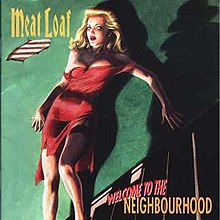Welcome to the Neighbourhood studio album by American rock singer Meat Loaf , released in 1995 as the follow-up to his successful comeback album Bat Out of Hell II: Back into Hell
Welcome to the Neighbourhood Released October 30, 1995 [ 1] Recorded April–August 1995 Genre Length 58 :56 Label Producer
The album is thought of as a concept album , as all of the songs are ordered in the track listing as to tell a story about a relationship throughout the years. Three singles were released: "I'd Lie for You (And That's the Truth) " (a duet with Patti Russo ), "Not a Dry Eye in the House " and "Runnin' for the Red Light (I Gotta Life) ". They reached #2, #7 and #21 in the UK charts, with the first two written by Diane Warren , who later also wrote songs for Meat Loaf's albums Couldn't Have Said It Better Bat Out of Hell III: The Monster Is Loose Casa De Carne (Live 2008) as a bonus CD with Hang Cool Teddy Bear Melbourne Symphony Orchestra , but only included as a bonus download track.
Of the 12 songs on the album, two are covers of songs from Jim Steinman projects; "Original Sin" first appeared on Pandora's Box 's Original Sin The Shadow Taylor Dayne ), and "Left in the Dark " first appeared on Steinman's own album Bad for Good
The theme on the cover art and inside booklet is that of detective novels of the 1950s. The booklet, aside from having the lyrics for every song, features a "Detective Novel" per song with modified titles to accommodate the titles of the songs. At least one image, the one associated with "Where Angels Sing" (the final track on the album), is easily recognizable: it is the same image, only with slightly altered colors, as in the movie poster for Lolita Stanley Kubrick 's film adaption of the controversial same-titled novel by Vladimir Nabokov ; the typeface used to write "Where Angels Sing" is also the same one as in the poster. This style was also used for the three singles released off the album, with the cover art for each of them being its correspondent novel from the booklet.
In 2011, a three disc collector's edition was released. The first disc includes the songs on the original release with four additional tracks.
The second disc was recorded live at the Beacon Theatre on 23 October 1995, except tracks 10 and 11 (recorded in 1989). Track 9 is, by mistake, the studio track.
The third disc is a five track DVD.
The Neverland Express
edit
Regular Meat Loaf studio sidemen
edit
^ "BPI certifications for Meat Loaf" .^ "Welcome to the Neighborhood - Meat Loaf | Songs, Reviews, Credits | AllMusic" . AllMusic ^ Ruhlmann, William. "Welcome to the Neighbourhood- Meat Loaf" . AllMusic . Retrieved October 23, 2018 . ^ Baltin, Steve (December 23, 1995). "Pop Albums" (PDF) . Cash Box . Retrieved November 10, 2022 . ^ Williams, Simon (25 November 1995). "Long Play". New Musical Express ISSN 0028-6362 . ^ Cross, Charles R. (2004). "Meat Loaf". In Brackett, Nathan; Hoard, Christian (eds.). The New Rolling Stone Album Guide Simon & Schuster . pp. 533 . ISBN 0-7432-0169-8 ^ "Australiancharts.com – Meat Loaf – Welcome to the Neighbourhood" . Hung Medien. Retrieved October 1, 2016.^ "Austriancharts.at – Meat Loaf – Welcome to the Neighbourhood" (in German). Hung Medien. Retrieved October 1, 2016.^ "Ultratop.be – Meat Loaf – Welcome to the Neighbourhood" (in Dutch). Hung Medien. Retrieved October 1, 2016.^ "Top RPM Albums: Issue 2826" . RPM Library and Archives Canada . Retrieved May 21, 2022.^ "Dutchcharts.nl – Meat Loaf – Welcome to the Neighbourhood" (in Dutch). Hung Medien. Retrieved October 1, 2016.^ "Meat Loaf: Welcome to the Neighbourhood" (in Finnish). Musiikkituottajat – IFPI Finland . Retrieved October 1, 2016.
^ "Offiziellecharts.de – Meat Loaf – Welcome to the Neighbourhood" (in German). GfK Entertainment Charts . Retrieved October 1, 2016.^ "Charts.nz – Meat Loaf – Welcome to the Neighbourhood" . Hung Medien. Retrieved October 1, 2016.^ "Norwegiancharts.com – Meat Loaf – Welcome to the Neighbourhood" . Hung Medien. Retrieved October 1, 2016.^ "Official Scottish Albums Chart Top 100" . Official Charts Company . Retrieved 21 November 2021.^ "Swedishcharts.com – Meat Loaf – Welcome to the Neighbourhood" . Hung Medien. Retrieved October 1, 2016.^ "Swisscharts.com – Meat Loaf – Welcome to the Neighbourhood" . Hung Medien. Retrieved October 1, 2016.^ "Official Albums Chart Top 100" . Official Charts Company . Retrieved November 21, 2021.^ "Meat Loaf Chart History (Billboard 200)" . Billboard ^ "The ARIA Australian Top 100 Albums 1995 (page 2)" . imgur.com. Retrieved May 21, 2022 .^ "Top RPM Albums: Issue 2839" . RPM Library and Archives Canada . Retrieved May 21, 2022.^ "End of Year Album Chart Top 100 – 1995" . Official Charts Company. Retrieved April 14, 2021 .^ "Top 100 Album-Jahrescharts" (in German). GfK Entertainment . Retrieved September 8, 2016 .^ "End of Year Album Chart Top 100 – 1996" . Official Charts Company. Retrieved April 14, 2021 .^ "Top Billboard 200 Albums – Year-End 1996" . Billboard . 2 January 2013. Retrieved April 14, 2021 .
